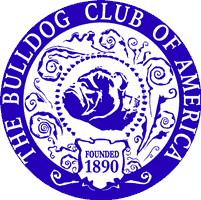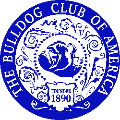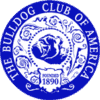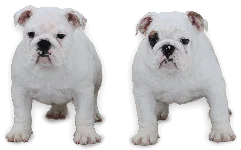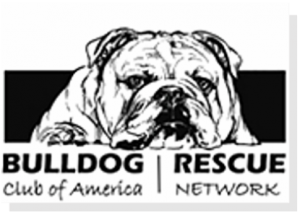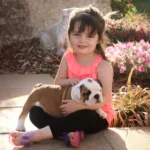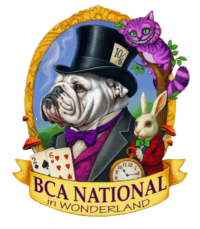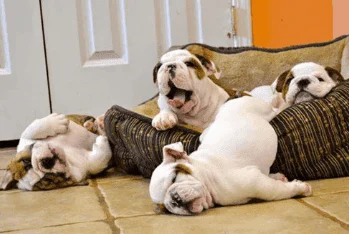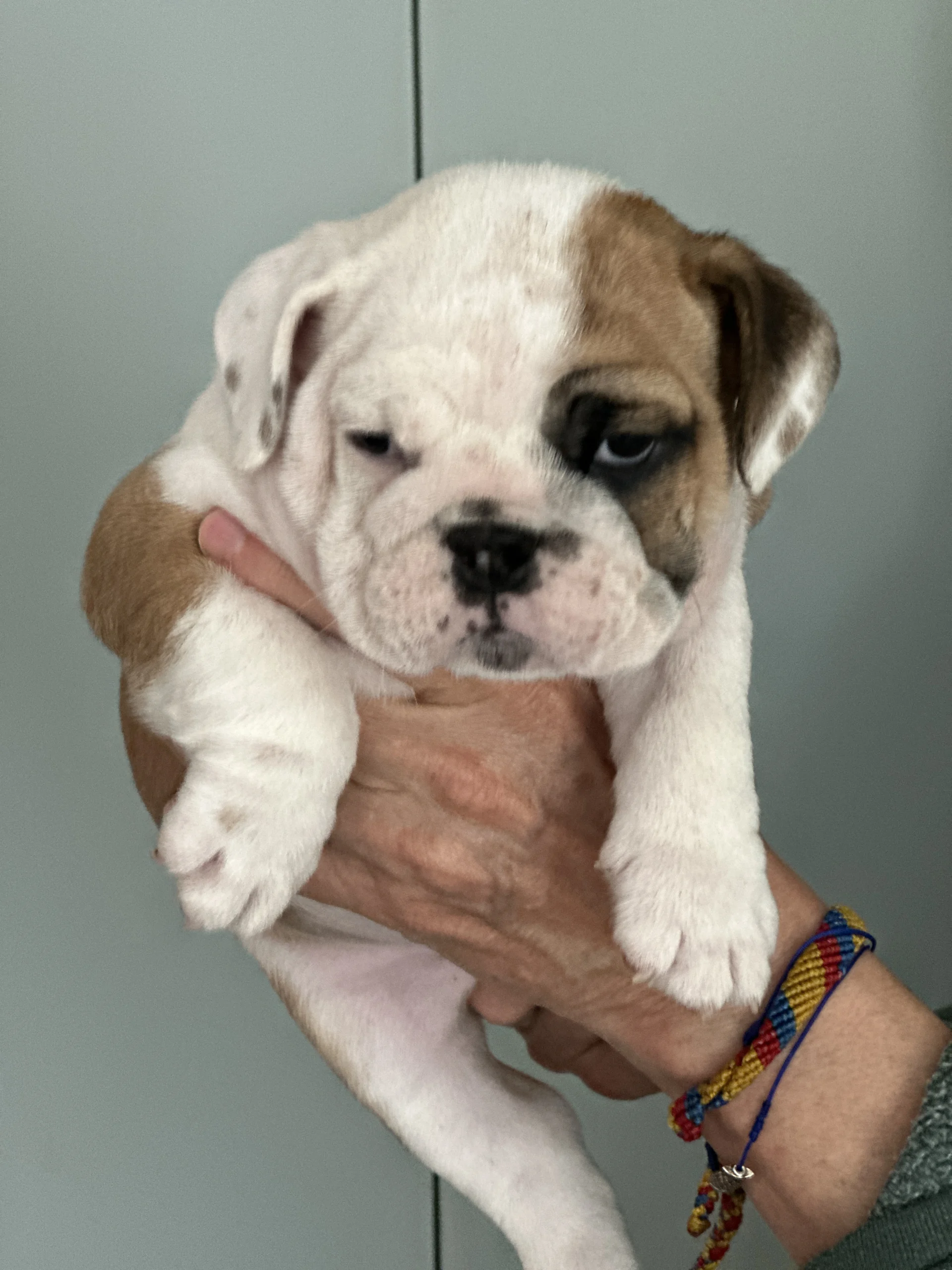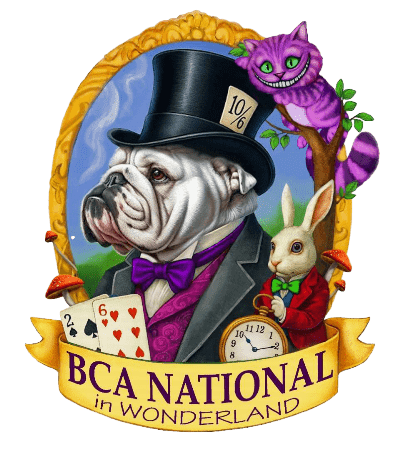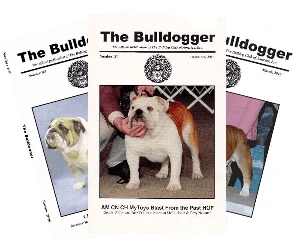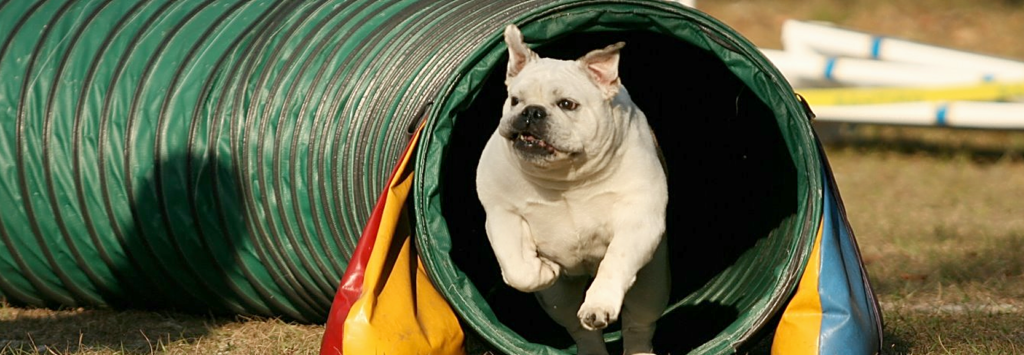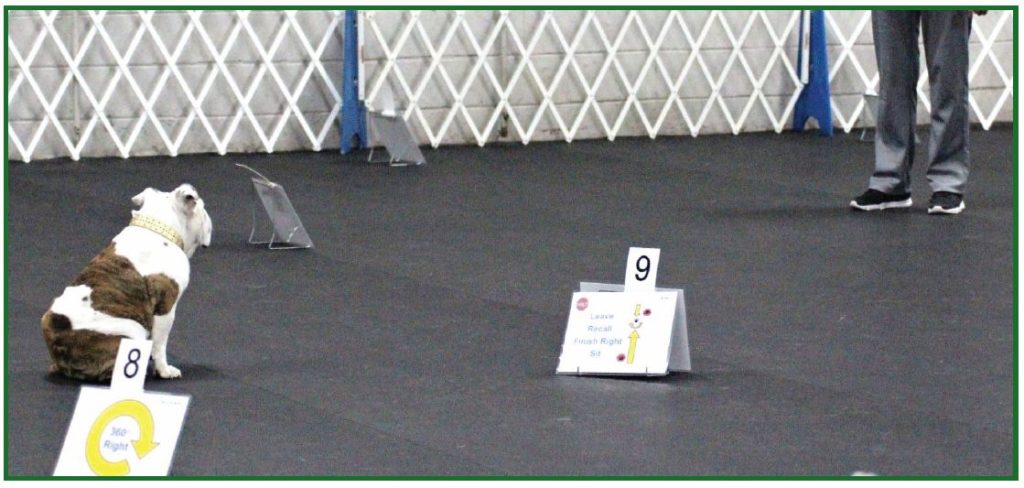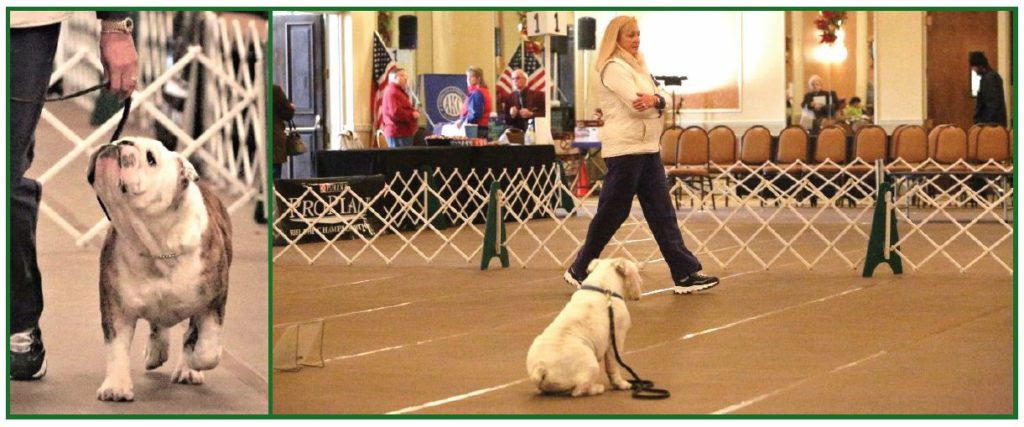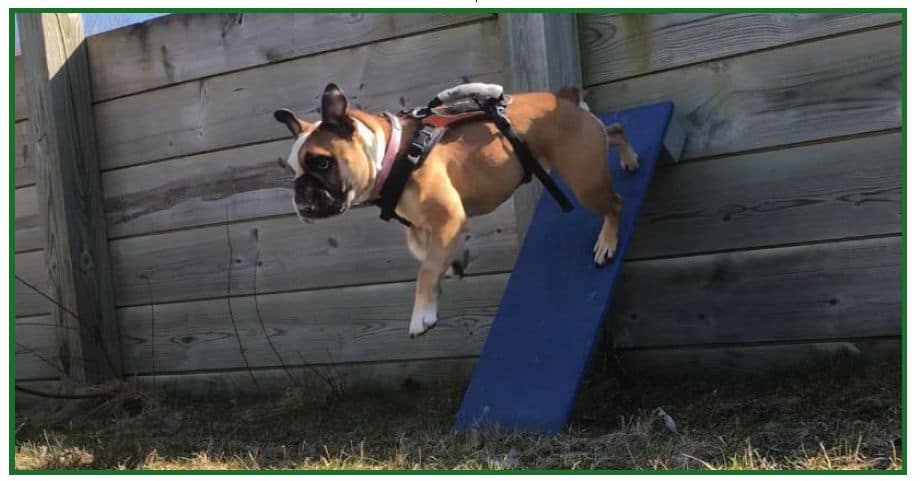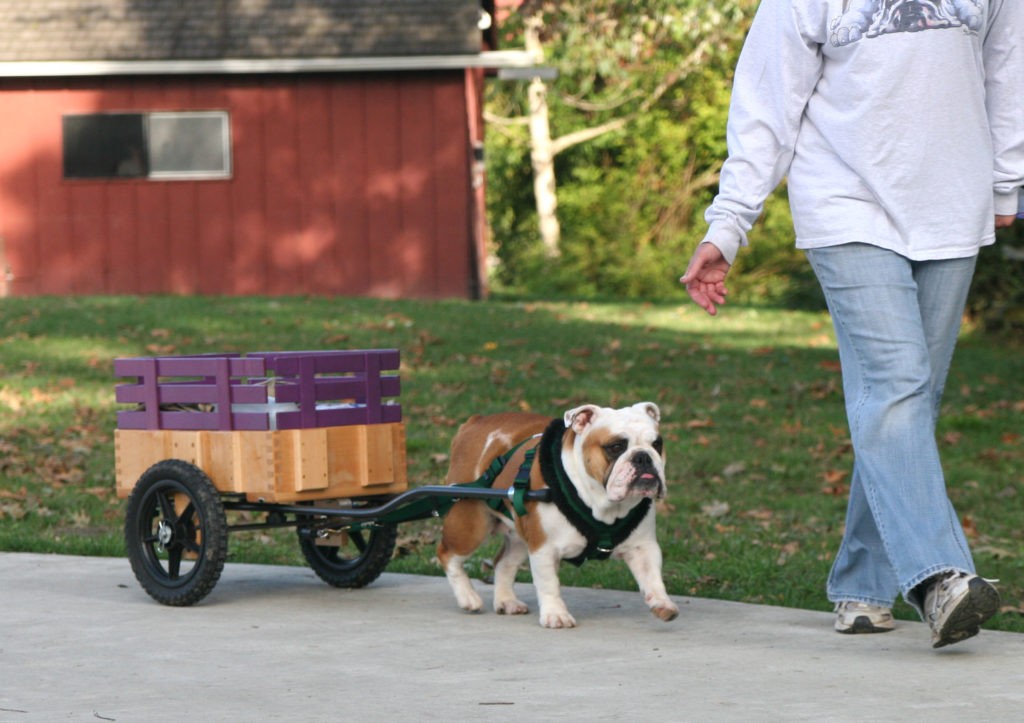Yes! Bulldogs do great in Performance; however, Bulldog owners who want to pursue Performance need to be cautioned … you are likely to become addicted! The competitive bug is apt to bite you, so you won’t want to stop at entry-level titles and will want to go on to experience the thrill of upper-level competition. Working together, as a team, to achieve exciting goals, will knit a relationship between you and your Bulldog that is like no other!
First and foremost, you’ll want to choose a healthy, sound puppy or adult, then look for these key traits…
ATTITUDE: The single most important trait that all performance dogs share is attitude - the willingness to work hard to succeed. It is evident in the dog that enjoys performing. He finds learning new skills stimulating and fun. The dog with attitude has the desire to do the job and will earn titles at the higher levels. Look for a dog that is inquisitive, bright and alert. Your working Bulldog should be curious about everything around him. He will also have a higher-than-average energy level. Puppies with attitude and drive make better Performance prospects, so you don’t want to stifle those qualities, but rather invest more effort in devising productive ways to channel their energy and curiosity. Look for a dog that follows and wants to be with you; he has higher pack drive and will attempt to please you as a pack member. A more independent dog will be harder to train, though not impossible. Retrieving is not an inherently strong trait in Bulldogs, so if you wish to pursue advanced levels of Obedience competition, retrieving skills will need to be nurtured. Try throwing a small toy just a few feet to see if he will go out to it and pick it up. Natural retrieving tendency is not essential, but it does make it easier to teach advanced retrieving exercises.
CONFORMATION: Good conformation and soundness are necessary components of a Performance Bulldog. The working parts of his anatomy are very important. He need not be a show prospect, but should have correct length of back as well as adequate shoulder and rear leg angulations. He should be balanced. Most importantly, he must be a good breather. A properly arched neck will aid his breathing. Try to avoid pinched nostrils. The Bulldog should be a very athletic, strong dog and therefore very capable of working.
ATTENTION: Attention is the basis for success in training and performing. Until your Bulldog will pay attention to you, you will make minimal progress. Attention-training will strengthen the bond between you and your Bulldog, resulting in the focus needed to perform well, even with a lot else going on in the surrounding environment. Dogs that do not pay attention to their owners are easily distracted in a performance venue, so may miss the cues their handlers give them and thereby fail an exercise.
Once you have found your working Bulldog, you must make use of his willingness and energy. Strive to direct those desirable traits into effective training sessions. Bear in mind that while it is unlikely that a great performance Bulldog can be made out of a poor prospect, it is highly likely that a potentially great Bulldog will be ruined by improper training methods. Decades ago, obedience training was largely accomplished through compulsion - physical manipulation, intimidation and popping the dog’s collar/leash to coerce the dog into complying. The dog would eventually learn what he needed to do in order to prevent being on the receiving end of physically and/or emotionally unpleasant acts. Modern training has abandoned those old-fashioned, unnecessary measures and instead advocates teaching our dogs through motivating them to offer the behaviors we want. We get the dog to offer the behaviors we are after, and strengthen those behaviors, by rewarding them. We use tidbits of yummy food or the dog’s favorite toy to lure him into the position or action we want, and then to reward him for getting it right. We can still let the dog know when he gets it wrong, but we don’t have to punish him for it. Rather, we just withhold the reward, or say, “Oops…Let’s try again!” And then we help the dog attain success and reward. Luring and reward-based teaching principles are very effective in facilitating the learning of Performance skills by Bulldogs. All dogs learn through the consequences associated with what they do. That is why dogs trained with compulsion worked to avoid those old punitive consequences, and why dogs trained with incentives will work to get something they value. Going to classes at a dog training facility that uses clicker/positive reinforcement methods is a great way to get off to the right start in having a well-behaved Bulldog that willingly performs his owner’s bidding. And since positive reinforcement is gentle, owners need not wait, and can take advantage of using it on very young puppies. Bulldogs like to make us happy, but if they are not successful, they seldom worry about it! The Bulldog does not find repetition exciting; nor is it productive. Repeating a portion of training 2-3 times, then moving on, is usually better than drilling over and over. Bulldogs are very intelligent and respond well to incentives. When they don’t do what we ask, it is usually because they don’t want to, not because they don’t understand what we’re asking of them. Our job is to encourage them to perform the actions we want by making training fun & rewarding. Trying to force a Bulldog to do anything is futile! Motivation is the path to earning performance titles. Most Bulldogs are motivated by food, but also enjoy other incentives/rewards, such as petting, praise, food, toys and fun games/interactions.
Part of properly preparing any Performance dog for competition is conditioning, and the Bulldog is no exception. As a thickset, low-slung, brachycephalic breed, Bulldogs do not tolerate exertion as well as slender, lithe dogs with long muzzles, but Bulldogs still need to be worked out physically, as part of a suitable conditioning regime. You cannot let your Bulldog lay around all week and then expect him to go out and perform a strenuous routine on the weekend. A regular exercise program with opportunity to run and play each day (with you, toys, other dogs) will get him to use his body efficiently and build strong muscles and ligaments. If possible, provide your dog with a varied-level area – playing on hills or banks improves strength and agility. Include a bit of low jumping, but don’t overdo it and limit puppies to below elbow height until their growth plates have closed. Watch your Bulldog’s weight. Excess pounds stress the soft tissues, joints and respiratory system. Exercise is a must, but take care to tailor it appropriately to your Bulldog’s build, stamina and age, and be cautious about training or performing in warm weather. Overheating is a concern for all dogs during exertion & in particular when it’s hot, so it’s imperative to have readily on hand water, towels, spray bottles, ice, cool pads and fans to use as needed.

Basic manners lay a lovely foundation upon which more advanced performance skills can be built. After your Bulldog has undergone some training and mastered the basics, he should be ready to be evaluated for titles in Civic Activities - an umbrella term used to refer to AKC’s Family Dog & other canine programs that are all about family & the community…
1) The dog functioning well at home and/or in the community – good manners, socialization skills, reaction to environmental stimuli, staying fit: Canine Good Citizenship, Virtual Home Manners, Farm Dog Certification, Temperament Testing, Fitness Workouts.
2) The dog entertaining family and/or the community – showing off tricks: Trick Dog, Stunt Dog.
3) The dog serving family members and/or the community – contributing to a person’s well-being: Therapy Dog.
Each of the above programs offers evaluations with elements that test specific skills/capabilities, some of which are: tricks, accepting a friendly stranger; sitting politely for petting & grooming; going out for a walk on a loose lead; walking through a crowd; doing a sit, down & stay in place; coming when called; walking over different surfaces; indoor & outdoor exercise; reacting appropriately to distracting sights & sounds, another dog or farm animal or weird-acting person; and accepting separation from the owner.
Performance Sports
Titles in Civic Activities are a great starting point for a Performance dog and can be stepping stones into the more difficult Performance Sports - titling events that are hosted by dog clubs or other canine organizations in which an approved Judge assesses the dog and its performance based on pertinent rules, regulations and standards. The Judge’s assessment ultimately determines if a dog meets the titling requirements set by the organization, and may take into account the dog’s physical traits and/or prowess; trained skills; natural tendencies, disposition, inherent abilities and attitude; physical and cognitive capabilities; motivation and willingness to engage in the sport and cooperate with the handler. Performance Sports include…
Since AKC’s launch of Rally in 2005, thru mid-2021, over 300 Bulldogs have titled. It remains a highly popular performance sport for Bulldogs. Rally is a spin-off from traditional, more rigid Obedience. Handlers appreciate that rules/regulations encourage them to communicate with their dogs throughout the exercises. Handers are allowed to talk freely to their dogs, repeat instructions, use signals and body language, and except for jumping, may retry any of the other exercises that don’t go right on the first attempt in all the levels but the very top level. The dog and handler can even be awarded a qualifying score without successfully completing every exercise. Rally is more about the handler and dog evidencing enjoyment in cooperating to meet minimal requirements than on precise execution of the exercises, so scoring is not as stringent as in Obedience. Rally requires the dog and handler to move along together on a course that contains a minimum of 10 stations at the beginning level, and a maximum of 20 stations at the uppermost levels. At each station is a sign that tells the handler what exercise to do with his dog before proceeding to the next station. The name for this canine event comes from Rally Style Auto Racing because in that sport, directional signs are also used to guide participants through the course. The exercises are comprised mainly of heeling, turns/changes of direction (that range between 90 and 360 degrees), halts, sits, downs, stands, stays, fronts & finishes, and at advanced/upper levels, jumps. Increased challenges (more stations & more difficult skills) are presented at each level of progression through the classes (Novice, Intermediate, Advanced, Excellent & Master) for titles, and a Championship title can be earned by dogs who do very well in the top 3 levels. At trials, handlers are allowed a course walk-thru prior to starting, so that they are familiar with the flow of the course and exercises called for, and are well-prepared to perform correctly and finish in the quickest time possible. A perfect score is 100 points. A team must earn at least 70 to qualify. In case of a tie, course times are used to determine placements. Rally is an ideal entry-level sport for dogs and handlers alike, from young to seniors. Not only does it provide a very doable venue for starting young dogs, and letting older dogs stay active, but it is a place for dogs and handlers to thrive as they get ready for more advanced work, to build confidence in the ring, or to just get out and have FUN!
Launched by AKC in the early 1930’s, Obedience is the oldest of organized canine Performance sports. Thru mid-2021, well over 600 Bulldogs have titled. Once you have established a good, working relationship with your dog and taught him the basics, you can pursue the more challenging, but very rewarding, goal of putting an obedience title on him. At all levels of obedience, the dog must be able to Heel - maintain position at the handler’s left side both when the handler is standing still and as the handler moves about the ring in pre-set patterns established by the judge. These Heeling patterns will be various sequences of going along at a normal pace with about turns, left & right turns and halts, and will also include a fast & slow pace.
At the Optional class entry level (Beginner Novice), in addition to the Heeling pattern on lead, the dog must also Heel on lead in a Figure 8 around 2 cones. The dog will have to: Sit for Exam (hold a sit at the handler’s left side while the judge touches the dog), come when called (Recall), and do a long Sit-Stay while the handler walks the inside perimeter of the ring.
At the Regular class entry level (Novice), in addition to the Heeling pattern & Figure 8 on lead, the dog will have to do the following off lead: the Heeling pattern, Stand for Exam (hold a stand 6 feet in front of the handler while the judge touches the dog), and Recall. The dog will also have to do long Sit & Down-Stays on lead with other dogs in the ring.
For the next level up in the Regular classes, (Open), all exercises are done off-lead, and in addition to the Heeling pattern & Figure 8, the exercises are: Command Discrimination (Stand, Down & Sit position changes - dog remains in first position as Handler walks away and then does the other 2 positions when cued by the handler from a distance), Drop on Recall (drop into a down when cued while moving toward the handler, then complete the recall), Retrieve on the Flat (go out and fetch a dumbbell tossed by the handler, bring it back & give it to the handler), Retrieve over the High Jump (go out over a jump to retrieve the tossed dumbbell and bring it back over the jump to deliver to the handler), Broad Jump (clear – go over without touching – a spread jump with the handler standing beside the jump), Stand Stay – Get Your Leash (hold the stand position where placed while the handler walks away to get the leash & returns).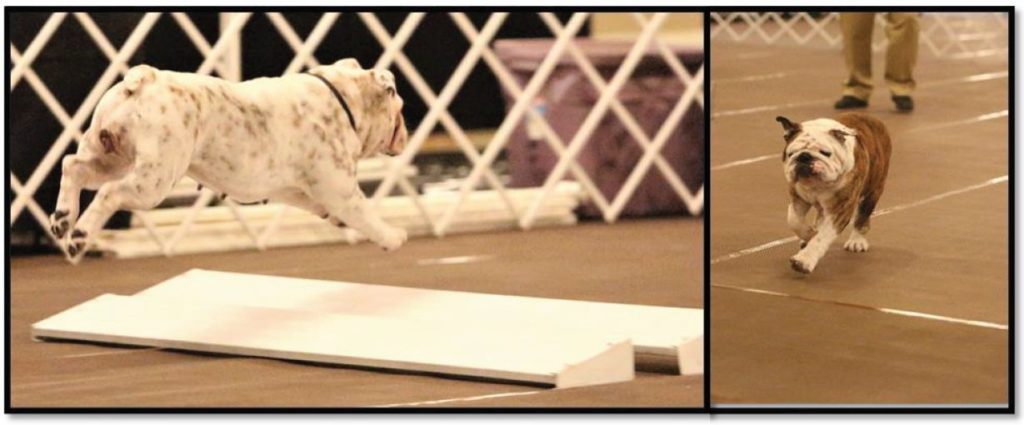
At the top/most challenging Regular class level (Utility), the exercises are all done off lead and are comprised of:
(1) Signals – dog must do the Heeling pattern ending in a stand-stay while the handler crosses the ring and then from that distance cues the dog to down, sit and come – the entire exercise is done by hand signals only – no verbal cues allowed;
(2) Scent Discrimination – dog must go out from the handler and discriminate an article scented by the handler placed in a pile of 8 other similar articles that do not have the handler’s scent on them, and pick up the scented article and carry it to the handler. This must be done with two articles made of different material – one metal, and the other leather or wood;
(3) Directed Retrieve – 3 gloves are placed at the end of the ring: one near each corner & the other in the center, while the dog & handler wait with their backs turned. The dog must then follow the handler’s direction (indication with hand/arm) to go retrieve the glove pointed to;
(4) Moving Stand & Exam – the dog must stop and hold a stand while heeling with the hander when the handler cues it stop & stand as the handler continues moving forward 10 feet. The dog must hold position while examined by the judge, then come when called by the handler;
(5) Directed Jumping – dog must go out across the ring between two jumps placed to the sides, then wait for the handler to cue him to come back across one of the jumps. The dog then goes out again and is cued to come back over the other jump.
Other Optional classes are Graduate Novice & Graduate Open which consist of exercises from the Regular classes that have been modified to use as stepping stones between Regular class Novice to Open, and Open to Utility. There is another set of classes called Preferred which follow the same title progression and exercises as in Regular with a few differences such as lower jumps and no group stays.
In Obedience, precision is strictly scored in half-points and the dog must respond promptly the first time a command is given, so there is little room for error. The dog must learn to focus on its handler, no matter what distraction or temptation may arise. Each dog enters the ring with a perfect 200 score from which points are deducted for not successfully completing an exercise, and for imperfections in heeling (lagging, forging, crowding, going wide), crooked sits, slow responses, etc. Titling can seem like a monumental feat to a beginner, but consistency and practice in many different environments will usually yield success.
Unlike most sports, tracking relies on the dog’s natural ability (sense of smell) rather than on his responses to cues from his handler. In fact, at a tracking test, the handler is not privy to the layout of the track, and even if he did know, rules prohibit guiding the direction that the dog goes.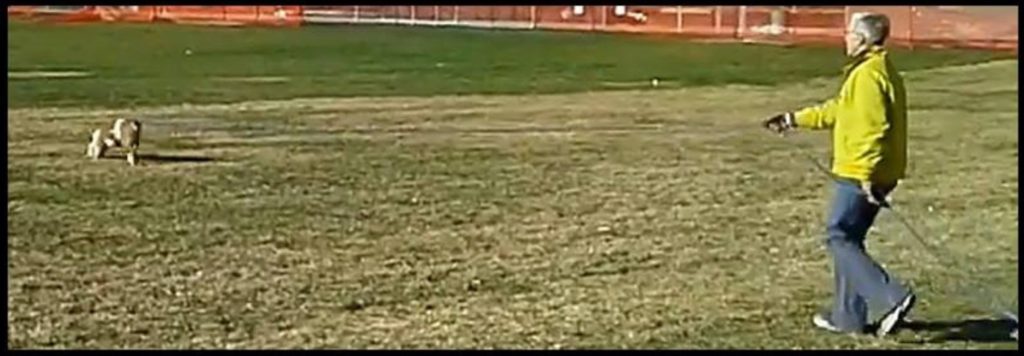
Tracking as an AKC sport began in 1937 when it was added as a part of the Utility level obedience exercises. Ten years later, AKC made tracking tests (and tracking titles) a separate event. Dogs instinctively use their noses, and even short-muzzled breeds like Bulldogs excel at it. While training and practice are needed to reinforce the dog for following the track from beginning to end, the dog (not the handler) is the one who knows where to go. A track for a test is laid (walked out by a human tracklayer) and the dog must later follow it. In essence, the dog is man-trailing.
At the novice level, the dog must follow a track that is 440-500 yards in length with 3-5 changes of direction, that has aged for 30 minutes to 2 hours. An article (such as a leather glove or wallet) is placed at the end of the track, and the dog must locate it. The dog wears a harness with a long lead attached that is held by the handler. The handler follows along behind the dog, at the end of the long lead. The handler may encourage the dog, but may not indicate what direction to go in. Tracking tests are held on different types of terrain/ground cover and more challenges are presented at upper levels, such as longer tracks, more turns, aged longer, a second set of tracks laid by another person across the main track (cross-tracks) and additional articles along the track that the dog must find & indicate are there. Thru mid-2021, nine Bulldogs have titled in AKC Tracking.
Launched by AKC in 2017, this relatively new sport has quickly caught on and 28 Bulldogs have already titled thru mid-2021. As in Tracking, the sport of Scent Work relies on the dog’s use of his nose, but instead of following a track of human scent (mimicking the profession of Search dogs that try to find people based on the scent left as they trail off), in this sport, the dog uses his nose to locate specific scents that are hidden (mimicking the task of working Detection dogs to locate a scent and communicate to the handler that the scent has been found). There are 2 Divisions: Odor Search & Handler Discrimination.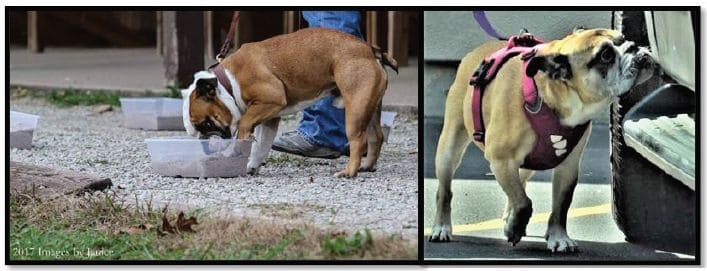
In Odor Search, four odors are used: Birch, Anise, Clove & Cypress. The elements they are hidden in are: 1) Container, 2) Interior, 3) Exterior, and 4) Buried. In the Container element, the target odor is concealed within a container (such as a cardboard box or briefcase), and the dog must indicate in which container, amongst several laid out, the scent is hidden. In the Interior element, the target odor is concealed on or in an object in an indoor search area. In the Exterior element, the target odor is concealed on or in an object in an outdoor search area (this requires the dog to locate the scent despite changing airflow patterns, weather conditions, and natural distractions). In the Buried element, the target odor is concealed within a small container and then submerged in sand or water. Each element has four classes, corresponding to four difficulty levels—1) Novice, 2) Advanced, 3) Excellent, and 4) Master. Dogs will begin with the Novice level classes and move up as they earn titles, and may progress through the elements at different speeds (i.e., a dog may compete in the Novice Interior class and the Advanced Container class). Factors such as the size of the search area, the number of hides, whether the number of hides is known or unknown to the handler, and the maximum height of the hides will change with the difficulty level. Three qualifying searches are required in order for the dog to earn a title in any of these classes. There is also a “Detective Class” for very accomplished dogs. In the Detective Class, dogs may encounter any element during one large search. The Detective Class contains multiple areas and many hides, all of which must be found to earn a qualifying score. The hides will be one or more of the target odors from the Odor Search Division. Ten qualifying scores are required to earn the Scent Work Detective title.
In Handler Discrimination, the target scent is that of the handler. Handlers come to the trial with one or more scented articles (such as a cotton glove or sock, cotton ball, or cotton swab) which will then be hidden on the course. The dog will need to locate the handler’s scent, discriminating it from all other scents, and indicate this find to the handler. The Handler Discrimination Division includes four classes: Novice, Advanced, Excellent, and Master. The Novice class is a Container search, Advanced class is an Interior search, and the Excellent class is an Exterior search, each increasing in difficulty. The Master class presents an integrated search in which dogs may encounter hides within any search environment. Three qualifying scores are required to earn titles in each of these classes.
Launched by AKC in 1994, many consider agility to be the ultimate game to play with their dogs, and the most fun and exciting to watch. It basically requires completing an obstacle course in a set time. Thru mid-2021, over 80 Bulldogs have titled. Dogs that compete in this rigorous sport need sound bodies, athletic conditioning, extensive training, consistent concentration and superb teamwork to succeed, especially beyond the entry & novice levels. The number of obstacles on the course ranges from a minimum of 10 for an Agility Course Test (entry level), up to 21 at the most challenging level (Premier). In addition to an increased number of obstacles as progression upward thru the classes goes, increased challenges include more side switches, harder approach angles & turns, faster times, and fewer faults allowed (no faults are allowed at the uppermost levels) to receive a qualifying score. A knocked jump bar on any course is an automatic failure. Within the Regular & Preferred classes, there are Jumpers courses & Standard courses. In Jumpers, the dog must be able to negotiate a variety of jumps, a set of weave poles, and tunnels. To fully participate, and compete in the Standard classes of the sport, the dog will also need to be able to correctly perform across a variety of ramps (A-frame, dogwalk & seesaw) and on the pause table. There are also games classes (Time 2 Beat & FAST). Judges design their own courses for use in the trials at which they officiate. Every course is different, but must conform to certain specifications. The dog must follow direction from the handler to take each obstacle in the correct sequence & perform as required as they race against the clock in this timed event. The team cannot qualify if they exceed allotted times. Handlers walk the course without their dogs to prepare for the flow and strategies needed for their runs with their dog. Dogs are measured and the height that they must jump (4, 8, 12, 16, 20 or 24 inches) is based on the height of the dog at the shoulder, and the class entered. Preferred classes jump 4” lower than Regular classes. Most Bulldogs fall into the 12” jump height, but quite a few are short enough for the 8” jump height. Back when Agility first started, and only Regular classes were offered, the few Bulldogs that participated jumped 16”.
AKC launched the sport of Coursing Ability as a titling event for all breeds in 2011. Dogs chase a lure (as sight hounds have done for many years in the sport of Lure Coursing) singularly on a long course with multiple turns & they must complete the run within an allotted time. The course length for Brachycephalic breeds (to include the Bulldog) is 300 yards. The course length for non-brachycephalic breeds is 600 yards. Titles are based on the number of qualifying runs accumulated. Thru mid-2021, 30 Bulldogs have titled.
AKC launched the sport of FAST CAT as a titling event for all breeds in 2016. Dogs chase a lure in a straight line, 100-yard dash. Titles are based on the number of points accumulated for how fast the dog runs. Thru mid-2021, 35 Bulldogs have titled.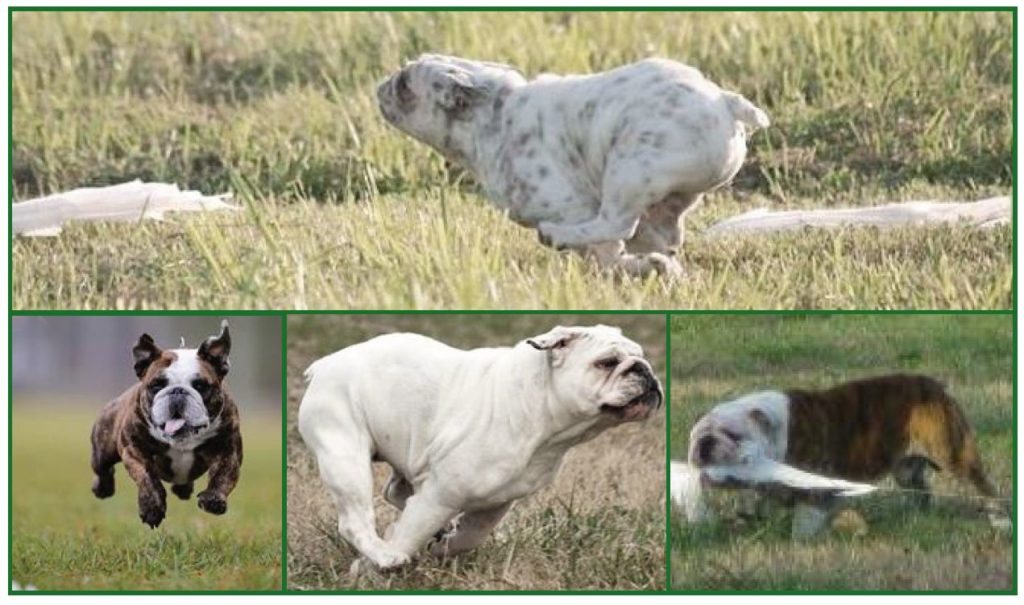
is all about dogs searching through a course of straw bales to locate rats that have been safely placed in containers and concealed in the straw. AKC does not hold this event, but gives recognition to titles earned from the Barn Hunt Association. Thru mid-2021, 16 Bulldogs have AKC recognized titles.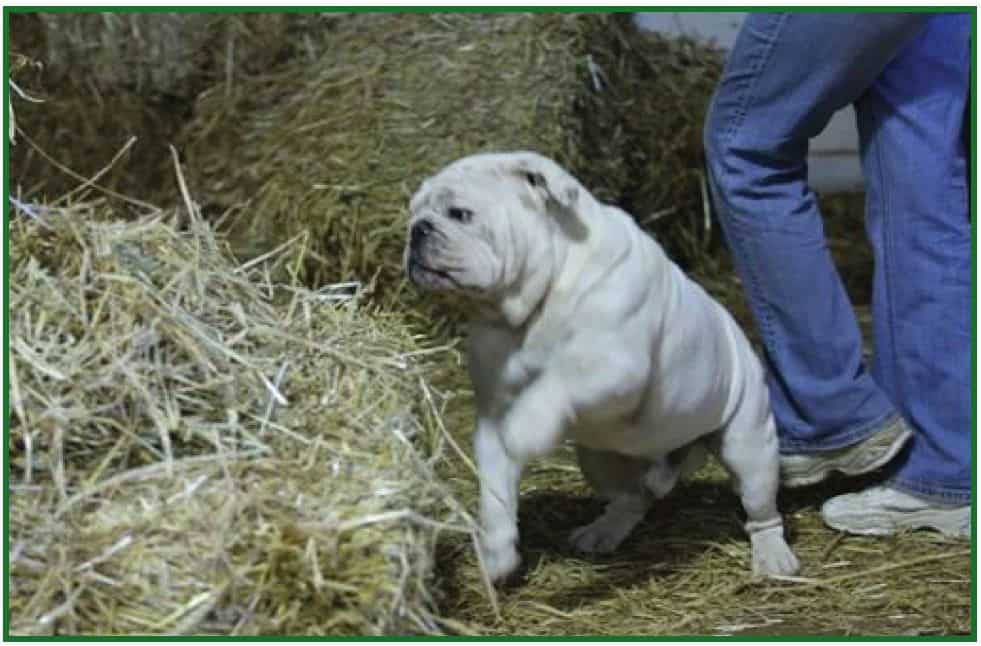
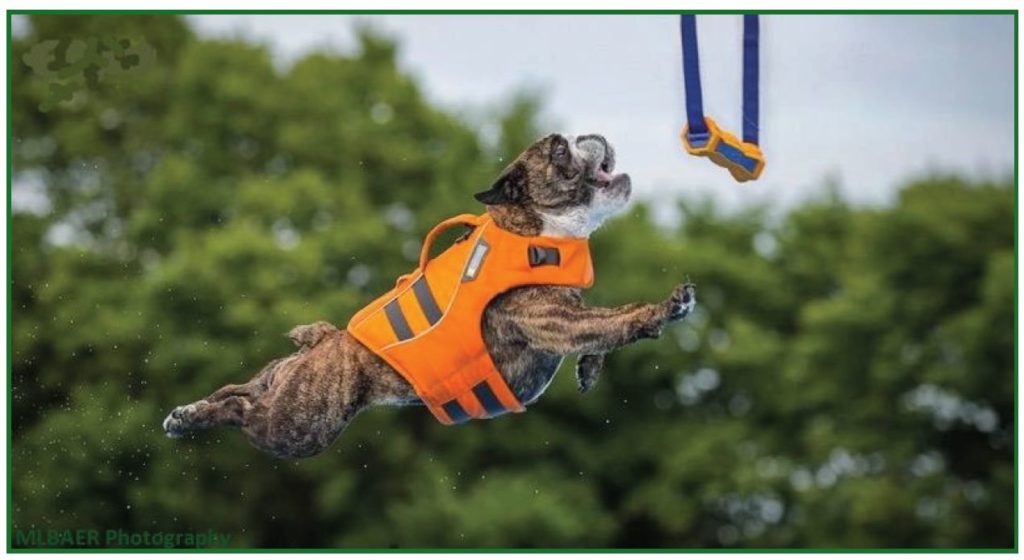 Dogs launch themselves off a platform (dock) into the pool below. There are three disciplines:
Dogs launch themselves off a platform (dock) into the pool below. There are three disciplines:
(1) Distance Jumping - focuses on achieving the longest horizontal leap possible from the dock out into the pool;
(2) Air Retrieve - focuses on achieving the longest leap possible off the dock while also leaping slightly upward to grab/release a bumper suspended over the pool, and
(3) Hydro Dash - focuses on achieving the fastest speed possible swimming to the end of the pool from the dock.
AKC does not hold Dock Diving trials, but gives recognition to titles earned at North America Diving Dog events. Thru mid-2021, 3 Bulldogs have AKC recognized titles. Bulldogs are not typically strong swimmers because their mass is front-loaded by large heads & chests that can weigh them down and they don’t have long legs. Most Bulldogs can swim, but should not be expected to for lengthy distances and not unsupervised or without the support of a flotation device. Bulldogs that train for & participate in this water sport should wear a properly fitted life vest.
The dog is hitched to a cart and pulls it along to perform a variety of exercises that usually include those done in Novice obedience: a Heeling pattern, Recall & Stay. Draft tests also include maneuvering exercises which typically include turns/circles, pace changes, backing up, working with distractions, going thru gates, figure 8s and serpentine weaving around cones or poles, stakes, etc. The dog will also be expected to freighthaul: go a long distance with weight placed in the cart. AKC titles for Bulldogs are not available at this time for this sport, but thru mid-2021, at least 6 Bulldogs have been awarded titles thru breed clubs that host tests open to all breeds (such as Bernese Mountain Dog, Greater Swiss Mountain Dog & Rottweiler).
Resources
Getting started…
1) The American Kennel Club (AKC): https://www.akc.org/expert-advice/sports/get-started-in-dog-sports-and-events/
Brief overviews of various sports/events with suggestions for how to get started & links to regulations. The AKC site also has a directory of clubs with a search function so you can locate a club based on the type of training, services, and competition it provides, and then attend classes in person. Customer Service can be reached at 919.233.9767.
2) The Bulldog Club of America (BCA): bulldogclubofamerica.org No one Knows Bulldogs like the BCA! An abundance of information is posted specific to Bulldogs training & earning titles & awards in sports & activities. BCA Member Clubs are listed geographically to make it easy to find those closest to you. The BCA has a Performance Committee dedicated to providing support, encouragement, how-to’s & awards to those interested in training & competing in sports & activities with their Bulldogs.
3) The Facebook Group - Bulldogs in Performance Events - Here there are many active Performance Bulldoggers who share experiences, photos & videos; offer training suggestions, and foster a sense of camaraderie.
4) YouTube – Videos that show almost anything you want to learn about how to train & perform in dog sports can be found for free on YouTube. AKC has heaps of YouTube videos that provide detailed information, examples and demonstrations.
5) Many trainers offer classes online, so you can look into getting help that way. A favorite amongst Bulldoggers is https://denisefenzi.com/train-with-denise-fenzi/
6) For comprehensive coverage of many sports/activities and lists of titled Bulldogs and their owners throughout history, up-to-date databases can be viewed at www.WildwoodKuvaszBulldogs.com (a BCA Performance Committee member’s website).

